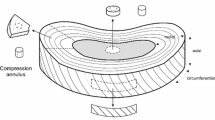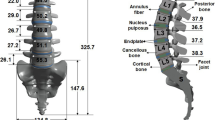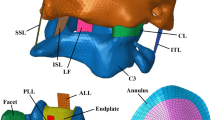Abstract
Degeneration of the intervertebral disc is related to progressive changes in the disc tissue composition and morphology, such as water loss, disc height loss, endplate calcification, osteophytosis. These changes may be present separately or, more frequently, in various combinations. This work is aimed to the biomechanical investigation of a wide range of clinical scenarios of disc degeneration, in which the most common degenerative changes are present in various combinations. A poroelastic non-linear finite element model of the healthy L4–L5 human spine segment was employed and randomly scaled to represent ten spine segments from different individuals. Six different degenerative characteristics (water loss in the nucleus pulposus and annulus fibrosus; calcification and thickness reduction of endplate cartilage; disc height loss; osteophyte formation; diffuse sclerosis) were modeled in 30 randomly generated models, 10 for each overall degree of degeneration (mild, moderate, severe). For each model, a daily loading cycle including 8 h of rest, 16 h in the standing position with superimposed two flexion–extension motion cycles was simulated. A tendency to an increase of stiffness with progressing overall degeneration was observed, in compression, flexion and extension. Hence, instability for mild degeneration was not predicted. Facet forces and fluid loss decreased with disc degeneration. Nucleus, annulus and endplate degeneration, disc height loss, osteophytosis and diffuse sclerosis all induced a statistically significant decrease in the total daily disc height variation, facet force and flexibility in flexion–extension. Therefore, grading systems for disc degeneration should include all the degenerative changes considered in this work, since all of them had a significant influence on the spinal biomechanics.




Similar content being viewed by others
References
Adams MA, Dolan P (2005) Spine biomechanics. J Biomech 38(10):1972–1983 (Review)
Adams MA, Dolan P, Hutton WC (1986) The stages of disc degeneration as revealed by discograms. J Bone Joint Surg Br 68(1):36–41
Adams MA, Dolan P, Hutton WC (1987) Diurnal variations in the stresses on the lumbar spine. Spine (Phila Pa 1976) 12(2):130–137
Adams MA, Freeman BJ, Morrison HP, Nelson IW, Dolan P (2000) Mechanical initiation of intervertebral disc degeneration. Spine (Phila Pa 1976) 25(13):1625–1636
Adams MA, Roughley PJ (2006) What is intervertebral disc degeneration, and what causes it? Spine (Phila Pa 1976) 31(18):2151–2161
Amonoo-Kuofi HS (1991) Morphometric changes in the heights and anteroposterior diameters of the lumbar intervertebral discs with age. J Anat 175:159–168
Argoubi M, Shirazi-Adl A (1996) Poroelastic creep response analysis of a lumbar motion segment in compression. J Biomech 29:1331–1339
Arun R, Freeman BJ, Scammell BE, McNally DS, Cox E, Gowland P (2009) What influence does sustained mechanical load have on diffusion in the human intervertebral disc?: an in vivo study using serial postcontrast magnetic resonance imaging. Spine (Phila Pa 1976) 34(21):2324–2333
Battié MC, Videman T, Kaprio J, Gibbons LE, Gill K, Manninen H, Saarela J, Peltonen L (2009) The Twin Spine Study: contributions to a changing view of disc degeneration. Spine J 9(1):47–59
Battié MC, Videman T, Levälahti E, Gill K, Kaprio J (2008) Genetic and environmental effects on disc degeneration by phenotype and spinal level: a multivariate twin study. Spine (Phila Pa 1976) 33(25):2801–2808
Ferguson SJ, Ito K, Nolte LP (2004) Fluid flow and convective transport of solutes within the intervertebral disc. J Biomech 37(2):213–221
Frobin W, Brinckmann P, Biggemann M, Tillotson M, Burton K (1997) Precision measurement of disc height, vertebral height and sagittal plane displacement from lateral radiographic views of the lumbar spine. Clin Biomech (Bristol, Avon) 12(Suppl 1):1–63
Galbusera F, Schmidt H, Neidlinger-Wilke C, Wilke HJ (2010) The effect of degenerative morphological changes of the intervertebral disc on the lumbar spine biomechanics: a poroelastic finite element investigation. Comp Methods Biomech Biomed Eng (in press)
Goel VK, Monroe BT, Gilbertson LG, Brinckmann P (1995) Interlaminar shear stresses and laminae separation in a disc. Finite element analysis of the L3–L4 motion segment subjected to axial compressive loads. Spine (Phila Pa 1976) 20(6):689–698
Gruber HE, Ashraf N, Kilburn J, Williams C, Norton HJ, Gordon BE, Hanley EN Jr (2005) Vertebral endplate architecture and vascularization: application of micro-computerized tomography, a vascular tracer, and immunocytochemistry in analyses of disc degeneration in the aging sand rat. Spine (Phila Pa 1976) 30(23):2593–2600
Gu WY, Mao XG, Foster RJ, Weidenbaum M, Mow VC, Rawlins BA (1999) The anisotropic hydraulic permeability of human lumbar anulus fibrosus. Influence of age, degeneration, direction, and water content. Spine (Phila Pa 1976) 24(23):2449–2455
Haefeli M, Kalberer F, Saegesser D, Nerlich AG, Boos N, Paesold G (2006) The course of macroscopic degeneration in the human lumbar intervertebral disc. Spine (Phila Pa 1976) 31(14):1522–1531
Holzapfel GA, Schulze-Bauer CA, Feigl G, Regitnig P (2005) Single lamellar mechanics of the human lumbar anulus fibrosus. Biomech Model Mechanobiol 3(3):125–140
Kirkaldy-Willis WH, Farfan HF (1982) Instability of the lumbar spine. Clin Orthop Relat Res 165:110–123
Kong MH, Morishita Y, He W, Miyazaki M, Zhang H, Wu G, Hymanson HJ, Wang JC (2009) Lumbar segmental mobility according to the grade of the disc, the facet joint, the muscle, and the ligament pathology by using kinetic magnetic resonance imaging. Spine (Phila Pa 1976) 34(23):2537–2544
Lai WM, Hou JS, Mow VC (1991) A triphasic theory for the swelling and deformation behaviors of articular-cartilage. J Biomech Eng 113:245–258
Lanir Y (1987) Biorheology and fluid flux in swelling tissues, II. Analysis of unconfined compressive response of transversely isotropic cartilage disc. Biorheology 24:189–205
Little JP, Adam CJ, Evans JH, Pettet GJ, Pearcy MJ (2007) Nonlinear finite element analysis of anular lesions in the L4/5 intervertebral disc. J Biomech 40(12):2744–2751
Mimura M, Panjabi MM, Oxland TR, Crisco JJ, Yamamoto I, Vasavada A (1994) Disc degeneration affects the multidirectional flexibility of the lumbar spine. Spine (Phila Pa 1976) 19(12):1371–1380
Nachemson A (1960) Lumbar intradiscal pressure. Experimental studies on post-mortem material. Acta Orthop Scand Suppl 43:1–104
Nakamura T, Iribe T, Asou Y, Miyairi H, Ikegami K, Takakuda K (2009) Effects of compressive loading on biomechanical properties of disc and peripheral tissue in a rat tail model. Eur Spine J 18(11):1595–1603
Natarajan RN, Williams JR, Andersson GB (2006) Modeling changes in intervertebral disc mechanics with degeneration. J Bone Joint Surg Am 88(Suppl 2):36–40 (Review)
Olsen S, Oloyede A, Adam C (2004) A finite element formulation and program to study transient swelling and load-carriage in healthy and degenerate articular cartilage. Comput Methods Biomech Biomed Eng 7(2):111–120
Panjabi MM, Goel V, Oxland T, Takata K, Duranceau J, Krag M, Price M (1992) Human lumbar vertebrae. Quantitative three-dimensional anatomy. Spine (Phila Pa 1976) 17(3):299–306
Pfirrmann CW, Metzdorf A, Zanetti M, Hodler J, Boos N (2001) Magnetic resonance classification of lumbar intervertebral disc degeneration. Spine (Phila Pa 1976) 26(17):1873–1878
Riches PE, Dhillon N, Lotz J, Woods AW, McNally DS (2002) The internal mechanics of the intervertebral disc under cyclic loading. J Biomech 35(9):1263–1271
Riches PE, McNally DS (2005) A one-dimensional theoretical prediction of the effect of reduced end-plate permeability on the mechanics of the intervertebral disc. Proc Inst Mech Eng H 219(5):329–335
Rohlmann A, Zander T, Schmidt H, Wilke HJ, Bergmann G (2006) Analysis of the influence of disc degeneration on the mechanical behaviour of a lumbar motion segment using the finite element method. J Biomech 39(13):2484–2490
Seidler A, Bergmann A, Jäger M, Ellegast R, Ditchen D, Elsner G, Grifka J, Haerting J, Hofmann F, Linhardt O, Luttmann A, Michaelis M, Petereit-Haack G, Schumann B, Bolm-Audorff U (2009) Cumulative occupational lumbar load and lumbar disc disease—results of a German multi-center case–control study (EPILIFT). BMC Musculoskelet Disord 7:10–48
Schmidt H, Galbusera F, Wilke HJ, Shirazi-Adl A (2010) Remedy for fictive negative pressure in biphasic finite element models of the intervertebral disc during unloading. Comput Meth Biomech Biomed Eng (in press)
Schmidt H, Heuer F, Drumm J, Klezl Z, Claes L, Wilke HJ (2007) Application of a calibration method provides more realistic results for a finite element model of a lumbar spinal segment. Clin Biomech (Bristol, Avon) 22:377–384
Schmidt H, Kettler A, Rohlmann A, Claes L, Wilke HJ (2007) The risk of disc prolapses with complex loading in different degrees of disc degeneration—a finite element analysis. Clin Biomech (Bristol, Avon) 22(9):988–998
Schmidt H, Shirazi-Adl A, Galbusera F, Wilke HJ (2010) Response analysis of the lumbar spine during regular daily activities—a finite element analysis. J Biomech 43(10):1849–1856
Shao Z, Rompe G, Schiltenwolf M (2002) Radiographic changes in the lumbar intervertebral discs and lumbar vertebrae with age. Spine (Phila Pa 1976) 27(3):263–268
Tanaka N, An HS, Lim TH, Fujiwara A, Jeon CH, Haughton VM (2001) The relationship between disc degeneration and flexibility of the lumbar spine. Spine J 1(1):47–56
Thompson RE, Pearcy MJ, Barker TM (2004) The mechanical effects of intervertebral disc lesions. Clin Biomech (Bristol, Avon) 19(5):448–455
Urban JP, Maroudas A (1981) Swelling of the intervertebral disc in vitro. Connect Tissue Res 9:1–10
Urban JP, McMullin JF (1985) Swelling pressure of the intervertebral disc: influence of proteoglycan and collagen contents. Biorheology 22:145–157
Urban JP, McMullin JF (1988) Swelling pressure of the lumbar intervertebral discs: influence of age, spinal level, composition, and degeneration. Spine 13:179–187
Urban JP, Roberts S (2003) Degeneration of the intervertebral disc. Arthritis Res Ther 5:120–130
Vernon-Roberts B, Moore RJ, Fraser RD (2008) The natural history of age-related disc degeneration: the influence of age and pathology on cell populations in the L4–L5 disc. Spine (Phila Pa 1976) 33(25):2767–2773
Wilke HJ, Neef P, Caimi M, Hoogland T, Claes LE (1999) New in vivo measurements of pressures in the intervertebral disc in daily life. Spine (Phila Pa 1976) 24(8):755–762
Wilke HJ, Rohlmann F, Neidlinger-Wilke C, Werner K, Claes L, Kettler A (2006) Validity and interobserver agreement of a new radiographic grading system for intervertebral disc degeneration: Part I. Lumbar spine. Eur Spine J 15(6):720–730
Wilke HJ, Rohlmann F, Ring C, Mack C, Neidlinger-Wilke C, Kettler A (2009) Is a mild intervertebral disc degeneration really a sign for an instability? 4 Deutscher Wirbelsäulenkongress, Jahrestagung der Deutschen Wirbelsäulengesellschaft. München. Eur Spine J 1742–1743
Acknowledgments
This project is funded by the EU FP-7 project GENODISC (HEALTH-F2-2008-201626).
Author information
Authors and Affiliations
Corresponding author
Additional information
Fabio Galbusera is a PhD student at the University of Ulm, Germany, and has an exclusive research collaboration with IRCCS Istituto Ortopedico Galeazzi, Milan, Italy.
Rights and permissions
About this article
Cite this article
Galbusera, F., Schmidt, H., Neidlinger-Wilke, C. et al. The mechanical response of the lumbar spine to different combinations of disc degenerative changes investigated using randomized poroelastic finite element models. Eur Spine J 20, 563–571 (2011). https://doi.org/10.1007/s00586-010-1586-4
Received:
Revised:
Accepted:
Published:
Issue Date:
DOI: https://doi.org/10.1007/s00586-010-1586-4




